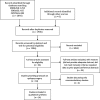Investigatory pathway and principles of patient selection for epilepsy surgery candidates: a systematic review
- PMID: 32183734
- PMCID: PMC7079385
- DOI: 10.1186/s12883-020-01680-w
Investigatory pathway and principles of patient selection for epilepsy surgery candidates: a systematic review
Abstract
Background: The predominant treatment for epilepsy is pharmacotherapy, yet 20-40% do not respond to anti-epileptic drugs. After becoming pharmacoresistant, some patients are worked-up to determine candidacy for epilepsy surgery. Despite the 2009 American Epilepsy Society guidelines, there is no broadly accepted criteria for the investigatory pathway and principles of patient selection for epilepsy surgery candidates. The objective of this systematic review is to elucidate what diagnostic pathways clinicians globally utilize.
Methods: Utilizing the Preferred Reporting Items for Systematic Reviews and Meta-Analysis (PRISMA) and the Cochrane Handbook of Systemic Reviews of Interventions, we conducted a systematic review through MEDLINE, Embase, and CENTRAL.
Results: From 2092 screened articles, 14 met inclusion criteria for qualitative synthesis. Structural MRI was required in all investigatory pathways. All but two articles required neuropsychological assessment. Six required neuropsychiatric assessment. Two protocols mentioned assessing the patient's support network. Three other protocols mentioned discussing expectations with patients. One also motioned conducing an occupational evaluation and making all surgery decisions in a multidisciplinary management conference. fMRI and the Wada test were required assessments in seven of the protocols. [18F]FDG-PET and SPECT were ancillary for all but three articles (where they were required). MEG and intracranial EEG were only mentioned as ancillary. Magnetic resonance (MR) spectroscopy was required at two institutes. With regards to the actual indication for selecting patients to begin the investigatory pathway, seven of the articles used a variation of the International League Against Epilepsy definition of refectory epilepsy, while one incorporated patient social history.
Conclusions: Despite attempts to standardize patient selection and investigatory pathways, no two protocols were identical. Scalp video/EEG telemetry, structural MRI, and neuropsychological assessment were the only assessments utilized in nearly all protocols. Socioeconomic restrictions appear to play a role in determining which tests are utilized in the investigatory pathway-not just for developing countries. However, cost-effective assessments, such as assessing patient support network and providing realistic expectation of outcomes, were only utilized in few protocols. In addition, no advanced imaging technologies (i.e., qMRI, 3D-MMI) were utilized. Overall, even amongst expert examiners there is significant variation throughout epilepsy centers globally, in selecting candidates and working up patients.
Keywords: Drug resistant epilepsy; Epilepsy surgery; Patient selection; Seizure; Seizure freedom; Temporal lobe epilepsy.
Conflict of interest statement
The authors declare that they have no competing interests.
Similar articles
-
Chronic unlimited recording electrocorticography-guided resective epilepsy surgery: technology-enabled enhanced fidelity in seizure focus localization with improved surgical efficacy.J Neurosurg. 2014 Jun;120(6):1402-14. doi: 10.3171/2014.1.JNS131592. Epub 2014 Mar 21. J Neurosurg. 2014. PMID: 24655096
-
Selecting patients for epilepsy surgery: synthesis of data.Epilepsy Behav. 2011 Feb;20(2):230-2. doi: 10.1016/j.yebeh.2010.06.040. Epub 2010 Aug 14. Epilepsy Behav. 2011. PMID: 20709601 Review.
-
[Surgery for intractable epilepsy--selection and presurgical evaluation].Rinsho Shinkeigaku. 1995 Dec;35(12):1356-60. Rinsho Shinkeigaku. 1995. PMID: 8752395 Review. Japanese.
-
Identifying potential surgical candidates in patients with evidence of bitemporal epilepsy.Epilepsia. 2003 Aug;44(8):1075-9. doi: 10.1046/j.1528-1157.2003.58302.x. Epilepsia. 2003. PMID: 12887439
-
Utility of electrocorticography in the surgical treatment of cavernomas presenting with pharmacoresistant epilepsy.Epileptic Disord. 2014 Sep;16(3):245-60. doi: 10.1684/epd.2014.0674. Epileptic Disord. 2014. PMID: 25204009 Review.
Cited by
-
The role of preoperative diffusion tensor imaging in predicting and improving functional outcome in pediatric patients undergoing epilepsy surgery: a systematic review.BJR Open. 2021 Jul 5;3(1):20200002. doi: 10.1259/bjro.20200002. eCollection 2021. BJR Open. 2021. PMID: 34381942 Free PMC article.
-
The Little-Known Ribbon-Shaped Piriform Cortex: A Key Node in Temporal Lobe Epilepsy-Anatomical Insights and Its Potential for Surgical Treatment.Diagnostics (Basel). 2024 Dec 17;14(24):2838. doi: 10.3390/diagnostics14242838. Diagnostics (Basel). 2024. PMID: 39767200 Free PMC article. Review.
-
The spatial relationship between the MRI lesion and intraoperative electrocorticography in focal epilepsy surgery.Brain Commun. 2022 Nov 21;4(6):fcac302. doi: 10.1093/braincomms/fcac302. eCollection 2022. Brain Commun. 2022. PMID: 36519154 Free PMC article.
References
-
- Organization WH . Neurological Disorders: Public Health Challenges—global burden of neurolgocial disorders. Geneva: WHO Press; 2016.
-
- Chen S, Chen Z, Wang S, Wu T, Zhou D, Cotton J, et al. Treatments for the idiopathic occipital lobe epilepsies. Cochrane Database Syst Rev. 2017;2017(12):CD012895.
-
- Guerrini R, Scerrati M, Rubboli G, Esposito V, Colicchio G, Cossu M, Marras CE, Tassi L, Tinuper P, Paola Canevini M, Quarato P, Giordano F, Granata T, Villani F, Giulioni M, Scarpa P, Barbieri V, Bottini G, Del Sole A, Vatti G, Spreafico R, Lo Russo G. Overview of presurgical assessment and surgical treatment of epilepsy from the Italian League Against Epilepsy. Epilepsia. 2013;54:35–48. 10.1111/epi.12308. - PubMed
Publication types
MeSH terms
LinkOut - more resources
Full Text Sources
Medical
Miscellaneous


